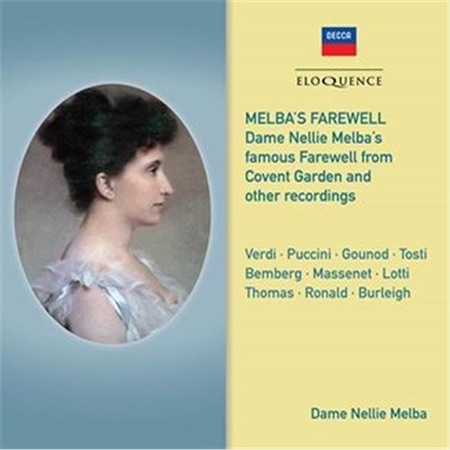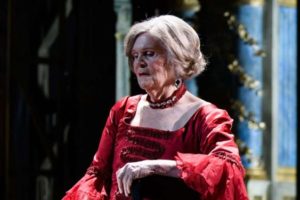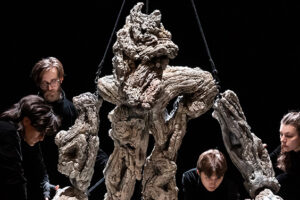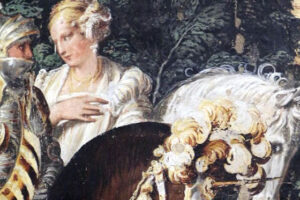

Those opera folk who weren’t reduced to floods of tears because of this artistic inhumanity I’m certain found solace, as many of us do, in the familiar. Desperately clinging to their vinyl box-sets and treasured momentos, if now care worn and faded from age, that fill their heads with the glories of opera seasons past. Like the proud ostrich we staunchly bury our heads in the sand to dampen the roar of the present and listen in vain to the echoes for the past.
The Eloquence label of Australia, the down under-arm of Decca and now by extension Deutsche Grammophon, seems to specialize in the re-release of many of these “Auld Lang Syne” treats. It’s where you can find highlights from the Sutherland-Bonynge faux-baroque Don Giovanni (cause who could take the whole thing?), the complete Irmgard Seefried oeuvre, and Leona Mitchell’s (treasured beyond rubies) debut album.
Two of their recent releases may be of great assistance in allowing our sisteren and bretheren to find their way back into the fold after “le traumatisme de Paris et Puccini.”
The first is a curate’s egg of sorts in the reissue of Dame Nellie Melba’s Covent Garden farewell concert recorded live by The Gramophone Company in 10 excerpts on the 8th of June, 1926. The most interesting part of this reissue is the adherence for the first time to the actual pitch of 435 hz which Dame Nellie preferred (it was called ‘French pitch’ back in the day) as opposed to pitching the 78’s at 440 hz’s as all previously releases have been.
If sources are to be believed Dame Nellie was 65 years old on the occasion of this concert and it can seem hard to believe after listening to her. The Gala consisted of Act II of Gounod’s Romeo et Juliette, the opening of Act IV of Verdi’s Otello (no need for an Otello to portion the spotlight) and Act’s III & IV of Puccini’s La Boheme. Unfortunately the evening’s Romeo, Charles Hackett, already had a recording contract with another label (in 1926!) so that portion is lost to posterity but what we do have is “cherce” as they say.
Melba was a towering figure both in music and in British society by this point and her most recent biographer, Ann Blainey in Marvelous Melba makes a point of showing how Dame Nellie fostered young, and in particular Australian, talent throughout her career since she herself had faced much prejudice because of her antipodean origins (and just as long as they weren’t lyric sopranos).
Not surprisingly the Rodolfo, Marcello, and Schaunard that evening all hailed from down under. Melba even fought to secure John Brownlee, the evening’s Marcello, his debut since he was deemed too inexperienced by management. He went on to the big international career that spanned 30 years at Covent Garden, the Paris Opera, and the Metropolitan proving Melba’s initial impression and astute eye for talent.
The eight musical excerpts from the evening prove telling in various ways. Dame Nellie was a student of the great vocal pedagogue Mathilde Marchesi and her singing sounds almost like an inverted pyramid of sound: very strongly supported at the top with a heavy reliance on chest resonance, but not support per se, on the bottom. There’s also quite a bit more straight tone than you might expect.
She’s touching in the Otello excerpts although her Italian is noticeably accented. Surprisingly this was a characteristic she carried over into all the languages she sang. I”m not sure if her occasional deficiencies of legato and pitch are stylistic or due to maturity but the top the voice has a bell-like quality that obviously carried well into the theatre.
It’s astonishing to discover that La bohème wasn’t initially the great success in London that you’d naturally assume and it took Melba’s insistence on singing the role of Mimi (which she had learned from Puccini himself) at Covent Garden before it captured an enthusiastic British public. The opera was barely a few years old when she sang it first and it was a bold step in her career to move into “modern” music from her generally bel canto-ish background.
The excerpts captured this night find her at her best. The duet with the aforementioned Marcello is especially fine and her “Senza rancor” is particularly moving with its closing phrases very distinctive. There’s an individuality to her singing that I think the modern critics of today would find unmusical yet it’s what makes her who she is.
The former Governor of the Australian State of Victoria makes a (silly, puffed-up) speech and then Melba herself bids her audience a brave but ultimately teary farewell. Musical cut-offs and entrances can be abrupt because of the primitive recording techniques and I would suggest listening on headphones to help diminish the ever present surface noise which can be tiring on the ear. Still the sound itself is shockingly immediate for its time and you really feel the moment.
Filling out the release is a handful of selections of song and opera recorded mostly in 1905 and 1910. A Jewel Song from Gounod’s Faust with piano accompaniment starts us off well. Dame Nellie sings with a very light touch on the ascending phrases and flaunts a tommy-gun perfect trill that most sopranos would kill their own mothers to posses. There follows on a very righteous final trio with orchestra and no less than John McCormack as Faust which is undistinguished by being sung in Italian.
Also among the collection is a very showy piece from Massenet’s Don Cézar de Bazan which would make some ambitious (and fearless) coloratura a wonderful party piece. Dame Nellie lays on the stacatti and trills like it’s a vocal fire sale. I’m afraid not all of them hit their intended mark but her target ratio is very high. She may be wrong but she’s never in doubt. A rather unremarkable “Vissi d’arte” is forgiven after hearing two completely charming Tosti songs.
Finally from 17 December 1926 La Melba’s very last recording which turns out to be a wildly incongruous but touching “Swing low, sweet chariot” in a slightly jazz age-tinged piano arrangement that’s lovely and all wrong at the same time. I don’t think I owned any Melba recordings before this but I’m happy to have this souvenir now of this great artist.

His last minute substitute was none other than Richard Tucker but since Mr. Tucker was under contract with RCA his contribution to the evening’s festivities couldn’t be included on the original vinyl release in 1957 or the first CD reissue in 2009. All of it recorded in glorious mono sound. So, hooray!
Conducting this gala affair was none other than Georg Solti in his single season as the Music Director for Chicago Lyric. He leads the resident orchestra in a rip-roaring rendition of Verdi’s sinfonia to La forza del destino which proves once again why it’s more popular than the opera that it precedes. This track is also making its CD debut because of time constraints on the original LP’s.
Then Giulietta SImionato renders up Saint-Saens famous “S’apre per te il mio cor” because this is the 50’s and they were still singing Carmen in the vernacular in Italy, let alone Samson et Dalila. She’s got all the breath she needs and also disdains to borrow the tenor’s B-flat at the finale which makes for a lovely and pensive ending.
So I’m certain no one present was surprised then when La Tebaldi took the stage and sang the Letter Scene from Eugene Onegin in Italian too. The liner notes say that Rudolf Bing had actually offered the role of Tatyana the Italian diva but she turned it down because she was afraid her English wasn’t good enough because we were still performing Tchaikovsky in the vernacular.
I can confess this now because I’m among friends. I’ve never really been a fan of Renata Tebaldi and this performance handily proves why. She just doesn’t have the smile of youth in her voice. I certainly recognize that it’s a gorgeous, voluptuous, instrument but she sounds matronly and brittle in a part that wants an extra dollop of juice and youth. I do love the way the composer wrote the quill dipping into the ink for the harp. For fans of the diva though I think this is a must have.
Mme. Simionato then graces us with back to back arias. First from Cavalleria rusticana with Santuzza’s “Voi lo sapete” and then Le Nozze di Figaro with Cherubino’s “Voi che sapete” which must qualify as some sort of party trick.
What a difference a “che” makes! For the Mascagni she’s all open throated glory and really slams into the chest voice at the finale to spine-tingling effect. The Mozart finds her beautifully judged and with a delicious restraint. It’s big house Mozart, no doubt about that, but still it proves beyond doubt, right there in front of you, what a spectacularly versatile artist she was.
Next we have Ettore Bastianini with the great monologue from Andrea Chenier, “Nemico della patria” and he’s well represented in this part both in live relays and the classic Decca set. I think he may be my favorite baritone because he really has a basso tonal quality but can thrillingly meet a baritones tessitura. Plus he’s got that gorgeous snarl in the voice that puts all his words across al dente. By this point you can tell the Chicago audience is really starting to get hyped.
Tebaldi offers up a sumptuous “L’altra notte” from Boito’s Mefistofele next and she’s near perfection even if she’s a mite hard on the top and with a sketchy trill. She’s surprisingly fleet in the rest of the fioratura bits and this is really what her voice was meant for. Needless to say the “bravo’s” rain down from the heavens.
Then you need to tuck in because these last two selections are going to finish you off but good. First we’ve got the “Who you calling a hussy?” duet from La Gioconda with Simionato and Tebaldi going tusk to tusk. For anyone who involuntarily flinches when they read the words, Tebaldi and Gioconda in the same sentence, I want to remind you this is 1956 not 1966.
They just tear the place up. Tebaldi starts plowing through her chest voice so hard (God bless her) Simionato starts sounding like the soprano in the equation. They even go for a little competitive note holding at the finale. There’s serious cheering from the crowd.
Then Richard Tucker shows up for the finale from Andrea Chenier and you’re ready to be taken to your reward. I have a good friend who was an Assistant House Manager at the Met back in the day and she says Tucker had the loudest voice she ever heard in the house.
He’s surprisingly poetic in the opening phrases but then the two of them start loosing what can only be described as a fussilade of vocal artillery on an audience that must already suffering from tinnitus. No one can touch Tebaldi in those ascending phrases on,”…il trionfo dell’amor!” She’s a beast.
No calling of the names at the end, just straight to the ”Viva la morte insiem!” The audience immediately starts applauding and can’t stop applauding all the way through the postlude. Solti continues to play on long after most conductors would have just given up. But posterity and all that.
I want to say just for the last four tracks on this it’s probably the best CD in your collection. I’m sorry I discovered this so late because it should have been my Christmas present to everyone I know.
























Comments